Expansion of Next-Generation Sustainable Clean Hydrogen Energy in South Korea: Domino Explosion Risk Analysis and Preventive Measures Due to Hydrogen Leakage from Hydrogen Re-Fueling Stations Using Monte Carlo Simulation
Abstract
:1. Introduction
2. Materials and Methods
2.1. Selection of Risk Assessment Site
2.2. Accident Scenario of Hydrogen Facility
2.3. Selection of Domino Explosion Parameters
2.4. Algorithm Procedure for the Monte Carlo Simulation-Based RL (Reinforcement Learning)
2.5. Prediction of the Domino Effect Using the Monte Carlo Model
2.6. Steps to Apply the Monte Carlo Model
- The data for a single explosion and the mathematical model for the convergence-type hydrogen refueling station were selected according to Figure 5. The parameters changed whenever each episode progressed, and the initial value setting determined the range of the domino explosion.
- Through reinforcement learning, an agent learns by observing the environment. The agent receives information by continuously monitoring which of the three high-risk hydrogen facilities will experience an accident first, the type of accident (fire or explosion), and the possibility of a chain reaction explosion due to an accident.
- Improved results were obtained by repeating a sufficient number of simulations to perform accurate predictions. Compensation for negative outcomes led to achieving representative results by regulating the conditions and executing fresh strategies to enhance policies. Deriving the maximum expected cumulative compensation for a domino explosion was achieved through policy enhancement.
- Analyzing the state value function obtained from the Monte Carlo simulation confirmed the probability and range of damage for the uncertain event leading to the domino explosion.
3. Results
3.1. Jet Fire and Fireball Analysis
3.2. Analysis of a Single Explosion
3.3. MCS Simulation for the Domino Effect
4. Conclusions
- PHAST software was used to conduct a quantitative risk assessment for a single explosion and found that the hydrogen tube trailer had the most significant effect on the explosion. The distance at which an explosion would occur due to excessive pressure, resulting in minor damage, was around 304 m from the point of explosion.
- After analyzing a single explosion using PHAST, a study on the consequences of a domino explosion was carried out using MCS, revealing a 69% probability of a domino explosion following a container rupture. Moreover, the range of damage exerted by the 3.5 kPa standard, where small damage (i.e., large and small windows are broken) occurs, was approximately 1000 m.
- The range of influence between a single explosion and a domino explosion differed by more than three times, showing that a convergence-type hydrogen refueling station in an urban area could lead to a major disaster without proper safety measures.
Author Contributions
Funding
Informed Consent Statement
Data Availability Statement
Conflicts of Interest
References
- Wei, R.; Lan, J.; Lian, L.; Huang, S.; Zhao, C.; Dong, Z.; Weng, J. A bibliometric study on research trends in hydrogen safety. Process Saf. Environ. Protect. 2022, 159, 1064–1081. [Google Scholar] [CrossRef]
- Al-Fatesh, A.S.; AL-Garadi, N.Y.A.; Osman, A.I.; Al-Mubaddel, F.S.; Ibrahim, A.A.; Khan, W.U.; Alanazi, Y.M.; Alrashed, M.M.; Alothman, O.Y. From plastic waste pyrolysis to fuel: Impact of process parameters and material selection on hydrogen production. Fuel 2023, 344, 128107. [Google Scholar] [CrossRef]
- Osman, A.I.; Mehta, N.; Elgarahy, A.M.; Hefny, M.; Al-Hinai, A.; Al-Muhtaseb, A.H.A. Hydrogen production, storage, utilization and environmental impacts: A review. Environ. Chem. Lett. 2022, 20, 153–188. [Google Scholar] [CrossRef]
- Hassan, Q.; Sameen, A.Z.; Salman, H.M.; Jaszczur, M.; Al-Jiboory, A.K. Hydrogen energy future: Advancements in storage technologies and implications for sustainability. J. Energy Storage 2023, 72, 108404. [Google Scholar] [CrossRef]
- Aydin, M.I.; Dincer, I. An assessment study on various clean hydrogen production methods. Energy 2022, 245, 123090. [Google Scholar] [CrossRef]
- Bao, Z.; You, S.; Hu, Z.; Wen, Y. Coordinated operation of hydrogen refueling and fast charging combo station under normal and contingent conditions. Energy Conv. Econ. 2020, 1, 171–183. [Google Scholar] [CrossRef]
- Perna, A.; Minutillo, M.; Micco, S.D.; Jannelli, E. Design and costs analysis of hydrogen refueling stations based on different hydrogen sources and plant configurations. Energies 2022, 15, 541. [Google Scholar] [CrossRef]
- Li, Y.; Wang, Z.; Shi, X.; Fan, R. Safety analysis of hydrogen leakage accident with a mobile hydrogen refueling station. Process Saf. Environ. Protect. 2023, 171, 619–629. [Google Scholar] [CrossRef]
- Intralink UK. The Hydrogen Economy South Korea: Market Intelligence Report. Available online: https://www.intralinkgroup.com/Syndication/media/Syndication/Reports/Korean-hydrogen-economy-market-intelligence-report-January-2021.pdf (accessed on 10 November 2023).
- Chang, X.; Bai, C.; Zhang, B. The effect of gas jets on the explosion dynamics of hydrogen-air mixtures. Process Saf. Environ. Protect. 2022, 162, 384–394. [Google Scholar] [CrossRef]
- Moon, S.B.; Lim, S.M.; Bang, I.C. Analysis of hydrogen and dust explosion after vacuum vessel rapture: Preliminary safety of Korean fusion demonstration reactor using MELCOR. Int. J. Energy Res. 2018, 42, 104–116. [Google Scholar] [CrossRef]
- Shang, S.; Zhang, J.; Zhang, J.; Luo, T.; Bi, M.; Jiang, H.; Li, Y.; Gao, W. Study on the effect of explosion suppression equipment on hydrogen explosions. J. Loss Prev. Process Ind. 2023, 83, 105046. [Google Scholar] [CrossRef]
- Jung, S.; Woo, J.; Kang, C. Analysis of severe industrial accidents caused by hazardous chemicals in South Korea from January 2008 to June 2018. Saf. Sci. 2020, 124, 104580. [Google Scholar] [CrossRef]
- Qian, J.; Li, X.; Gao, Z.; Jin, Z. A numerical study of unintended hydrogen release in a hydrogen refueling station. Int. J. Hydrogen Energy 2020, 45, 20142–20152. [Google Scholar] [CrossRef]
- Tan, W.J.; Ban, Z.H.; Chen, B.; Kim, K.L.; Siwayanan, P.; Choong, T.S.Y.; Lau, K.K. Enhanced mitigation of fire and explosion risks due to hydrogen leakage using targeted nitrogen nozzle spray approach. ACS Chem. Health Saf. 2022, 29, 309–318. [Google Scholar] [CrossRef]
- Park, B.; Kim, Y.; Park, J.O.; Lim, O.K. Jet flame risk analysis for safe response to hydrogen vehicle accident. Sustainability 2023, 15, 9884. [Google Scholar] [CrossRef]
- Kwon, D.; Choi, S.K.; Yu, C. Improved safety by cross analyzing quantitative risk assessment of hydrogen refueling stations. Int. J. Hydrogen Energy 2022, 47, 10788–10798. [Google Scholar] [CrossRef]
- Cirrone, D.; Makarov, D.; Molkov, V. Rethinking “BLEVE explosion” after liquid hydrogen storage tank rupture in a fire. Int. J. Hydrogen Energy 2023, 48, 8716–8730. [Google Scholar] [CrossRef]
- Li, Z.; Pan, X.; Ma, J. Quantitative Risk Assessment on a Hydrogen Refueling Station in Shanghai. Int. J. Hydrogen Energy 2010, 35, 6822–6829. [Google Scholar]
- Shi, J.; Chang, Y.; Khan, F.; Zhu, Y.; Chen, G. Methodological improvements in the risk analysis of urban hydrogen fueling station. J. Clean. Prod. 2020, 257, 120545. [Google Scholar]
- Abohamzeh, E.; Salehi, F.; Sheikholeslami, M.; Abbassi, R. Review of hydrogen safety during storage, transmission, and applications processes. J. Loss Prev. Process Ind. 2021, 72, 104569. [Google Scholar]
- Yu, X.; Yan, W.; Liu, Y.; Zhou, P.; Li, B.; Wang, C. The flame mitigation effect of vertical barrier wall in hydrogen refueling stations. Fuel 2022, 315, 123265. [Google Scholar] [CrossRef]
- Park, B.; Kim, Y.; Paik, S.; Kang, C. Numerical and experimental analysis of jet release and jet flame length for qualitative risk analysis at hydrogen refueling station. Process Saf. Environ. Protect. 2021, 155, 145–154. [Google Scholar] [CrossRef]
- Jallais, S.; Vyazmina, E.; Miller, D.; Thomas, J.K. Hydrogen jet vapor cloud explosion: A model for predicting blast size and application to risk assessment. Process Saf. Environ. Protect. 2018, 37, 397–410. [Google Scholar] [CrossRef]
- Suzuki, T.; Shiota, K.; Izato, Y.; Komori, M.; Sato, K.; Takai, Y.; Ninomiya, T.; Miyake, A. Quantitative risk assessment using a Japanese hydrogen refueling station model. Int. J. Hydrogen Energy 2021, 46, 8329–8343. [Google Scholar] [CrossRef]
- Tanaka, T.; Azuma, T.; Evans, J.A.; Cronin, P.M.; Johnson, D.M.; Cleaver, R.P. Experimental study on hydrogen explosions in a full-scale hydrogen filling station model. Int. J. Hydrog. Energy 2007, 32, 2162–2170. [Google Scholar] [CrossRef]
- Xu, Y.; Reniers, G.; Yang, M.; Yuan, S.; Chen, C. Uncertainties and their treatment in the quantitative risk assessment of domino effects: Classification and review. Process Saf. Environ. Protect. 2023, 172, 971–985. [Google Scholar] [CrossRef]
- Nolan, D.P. Handbook of Fire and Explosion Protection Engineering Principles for Oil, Gas, Chemical, and Related Facilities, 1st ed.; Gulf Professional Publishing: Houston, TX, USA, 2019; pp. 279–302. [Google Scholar]
- Ji, J.; Tong, Q.; Khan, F.; Dadashzadeh, M.; Abbassi, R. Risk-based domino effect analysis for fire and explosion accidents considering uncertainty in processing facilities. Ind. Eng. Chem. Res. 2018, 57, 3990–4006. [Google Scholar] [CrossRef]
- He, Z.; Weng, W. Synergic effects in the assessment of multihazard coupling disasters: Fires, explosion, and toxicant leaks. J. Hazard. Mater. 2020, 388, 121813. [Google Scholar] [CrossRef] [PubMed]
- Zhou, J.; Reniers, G. A matrix-based modeling and analysis approach for fire-induced domino effects. Saf. Environ. Protect. 2018, 116, 347–353. [Google Scholar] [CrossRef]
- Landucci, G.; Necci, A.; Antonioni, G.; Argenti, F.; Cozzani, V. Risk assessment of mitigated domino scenarios in process facilities. Reliab. Eng. Syst. Saf. 2017, 160, 37–53. [Google Scholar] [CrossRef]
- Khakzad, N.; Lanfucci, G.; Reniers, G. Application of dynamics Bayesian network to performance assessment of fire protection systems during domino effects. Reliab. Eng. Syst. Saf. 2017, 167, 232–247. [Google Scholar] [CrossRef]
- Jia, C.; Zhou, J.; He, H.; Li, J.; Wei, Z.; Li, K. Health-conscious deep reinforcement learning energy management for fuel cell buses integrating environmental and look-ahead road information. Energy 2023, 290, 130146. [Google Scholar] [CrossRef]
- Jia, C.; He, H.; Zhou, J.; Li, J.; Wei, Z.; Li, K. Learning-based model predictive energy management for fuel cell hybrid electric bus with health-aware control. Appl. Energy 2024, 355, 122228. [Google Scholar] [CrossRef]
- Park, B.; Kim, Y.; Lee, K.; Paik, S.; Kang, C. Risk assessment method combining independent protection layers (IPL) of layer of protection analysis (LOPA) and RISKCURVES software: Case study of hydrogen refueling stations in urban areas. Energies 2021, 14, 4043. [Google Scholar] [CrossRef]
- Omatick, T.; Zhang, D.; Blais, M.S.; Mossolly, M.; Renzi, P.; Kurz, R.; Freund, S.; Harvey, S. Usage. In Machinery and Energy Systems for the Hydrogen Economy, 1st ed.; Brun, K., Allison, T., Eds.; Elsevier Inc.: New York, NY, USA, 2022; pp. 251–304. [Google Scholar]
- Nakayama, J.; Misono, H.; Sakamoto, J.; Kasai, N.; Shibutani, T.; Miyake, A. Simulation-based safety investigation of a hydrogen fueling station with an on-site hydrogen production system involving methylcyclohexane. Int. J. Hydrogen Energy 2017, 42, 10636–10644. [Google Scholar] [CrossRef]
- LaChance, J.L.; Houf, W.G.; Fluer, L.; Middleton, B. Analyses to Support Development of Risk-Informed Separation Distances for Hydrogen Codes and Standards; Sandia Report (SAND2009-0874); Sandia National Laboratories: Albuquerque, NM, USA, 2009.
- Dadashzadeh, M.; Ahmad, A.; Khan, F. Dispersion modeling and analysis of hydrogen fuel gas released in an enclosed area: A CFD-based approach. Fuel 2016, 184, 192–201. [Google Scholar] [CrossRef]
- Center for Chemical Process Safety. Guidelines for Evaluating the Characteristics of Vapor Cloud Explosions, Flash Fires, and BLEVEs, 1st ed.; American Institute of Chemical Engineers: New York, NY, USA, 1994; pp. 247–336. [Google Scholar]
- Korea Meteorological Administration. Weather Information. Available online: https://www.weather.go.kr/ (accessed on 13 October 2023).
- Hao, Z.J.; Maio, F.D.; Zio, E. Monte Carlo Tree Search-based Deep Reinforcement Learning for Flexible Operation & Maintenance Optimization of a Nuclear Power Plant. J. Saf. Sustain. 2023, in press. [Google Scholar] [CrossRef]
- Huang, K.; Chen, G.; Khan, F.; Yang, Y. Dynamic analysis for fire-induced domino effects in chemical process industries. Process Saf. Environ. Protect. 2021, 148, 686–697. [Google Scholar] [CrossRef]
- Furen, Z.; Jiao, L.; Xiumei, X. Analysis and stimulation on LPG Station Explosion Hazards based on Monte-Carlo Method. In Proceedings of the 2011 Fourth International Symposium on Knowledge Acquisition and Modeling, Sanya, China, 8 October 2011; pp. 104–107. [Google Scholar]
- Red, A.; Abdolhamidzadeh, B.; Abbasi, T.; Rashtchian, D. FREEDOM II: An improved methodology to assess domino effect frequency using simulation techniques. Process Saf. Environ. Protect. 2014, 92, 714–722. [Google Scholar] [CrossRef]
- Singh, V.; Chen, S.; Singhania, M.; Nanavati, B.; Kar, A.; Gupta, A. How are reinforcement learning and deep learning algorithms used for big data based decision making in financial industries—A review and research agenda. Int. J. Inf. Manag. Data Insights 2022, 2, 100094. [Google Scholar] [CrossRef]
- Morales, M. Grokking Deep Reinforcement Learning, 1st ed.; Manning Publications: Shelter Island, NY, USA, 2020; pp. 1–55. [Google Scholar]
- Benzi, M.; Evans, T.M.; Hamilton, S.P.; Pasini, M.L.; Slattery, S.R. Analysis of Monte Carlo accelerated iterative methods for sparse liner systems. Numer. Linear Algebra 2017, 24, e2088. [Google Scholar] [CrossRef]
- Li, Y.; Wang, Y.; Lai, Y.; Shuai, J.; Zhang, L. Monte Carlo-based quantitative risk assessment of parking areas for vehicles carrying hazardous chemicals. Reliab. Eng. Syst. Saf. 2023, 231, 109010. [Google Scholar] [CrossRef]
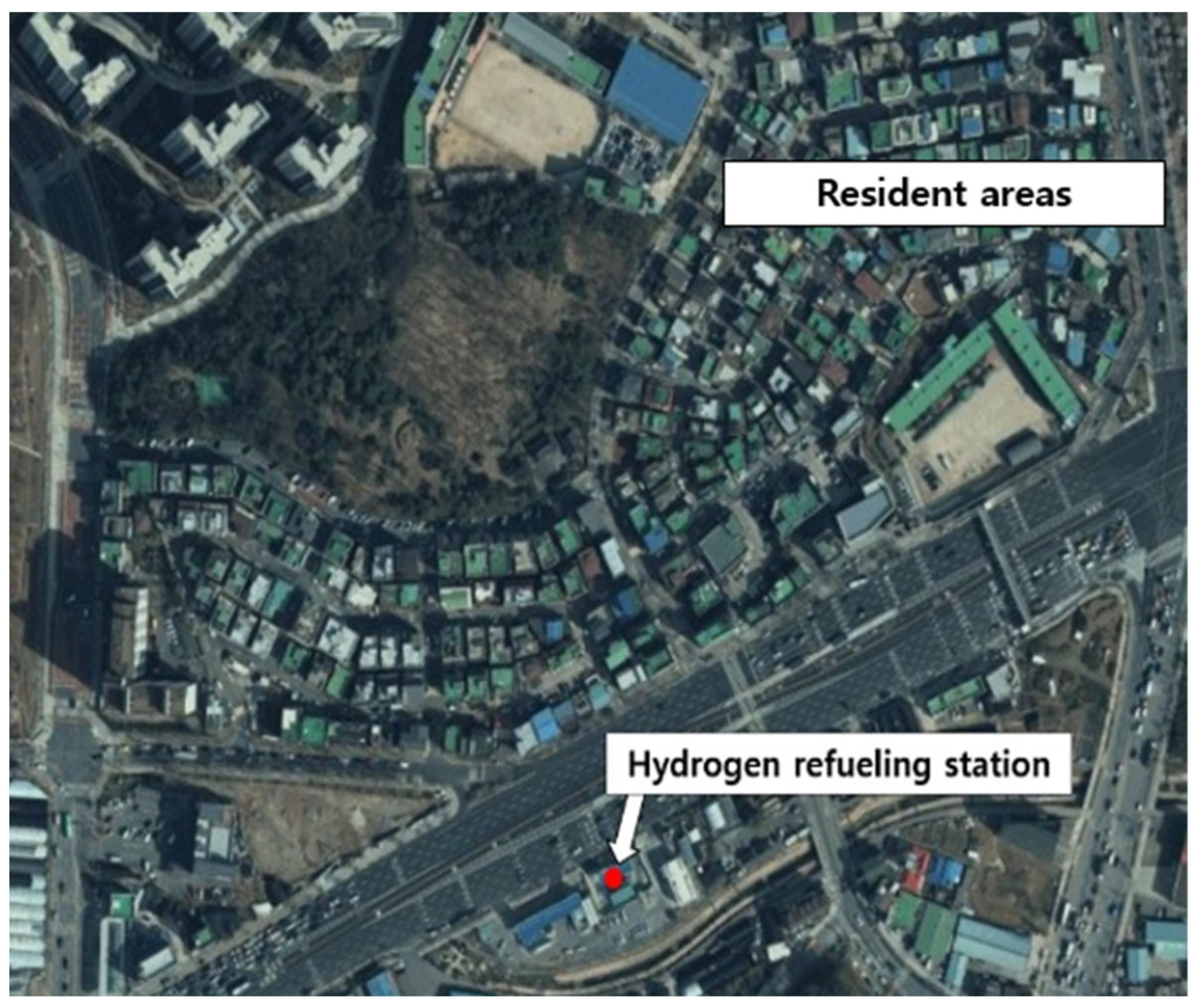
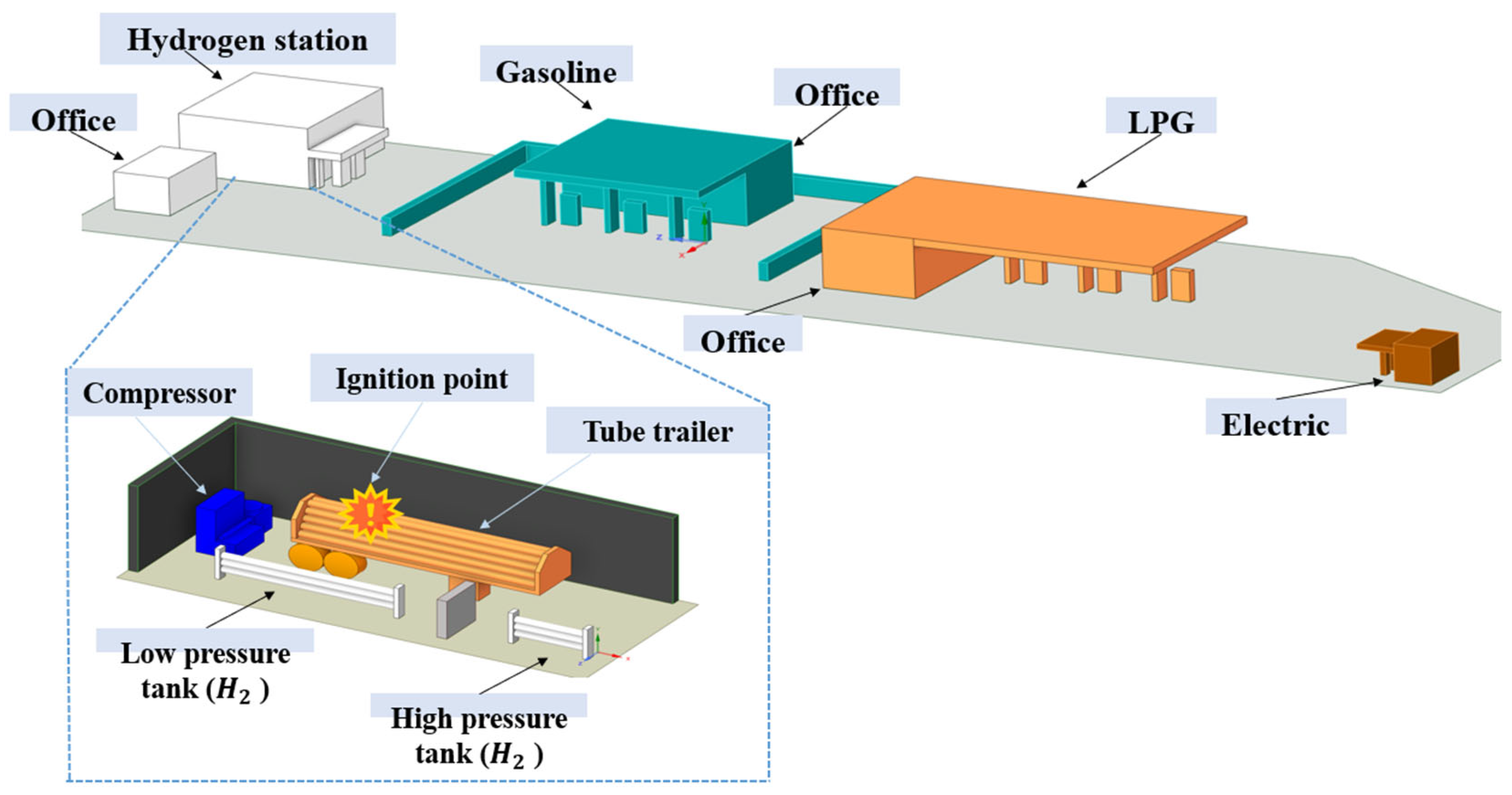
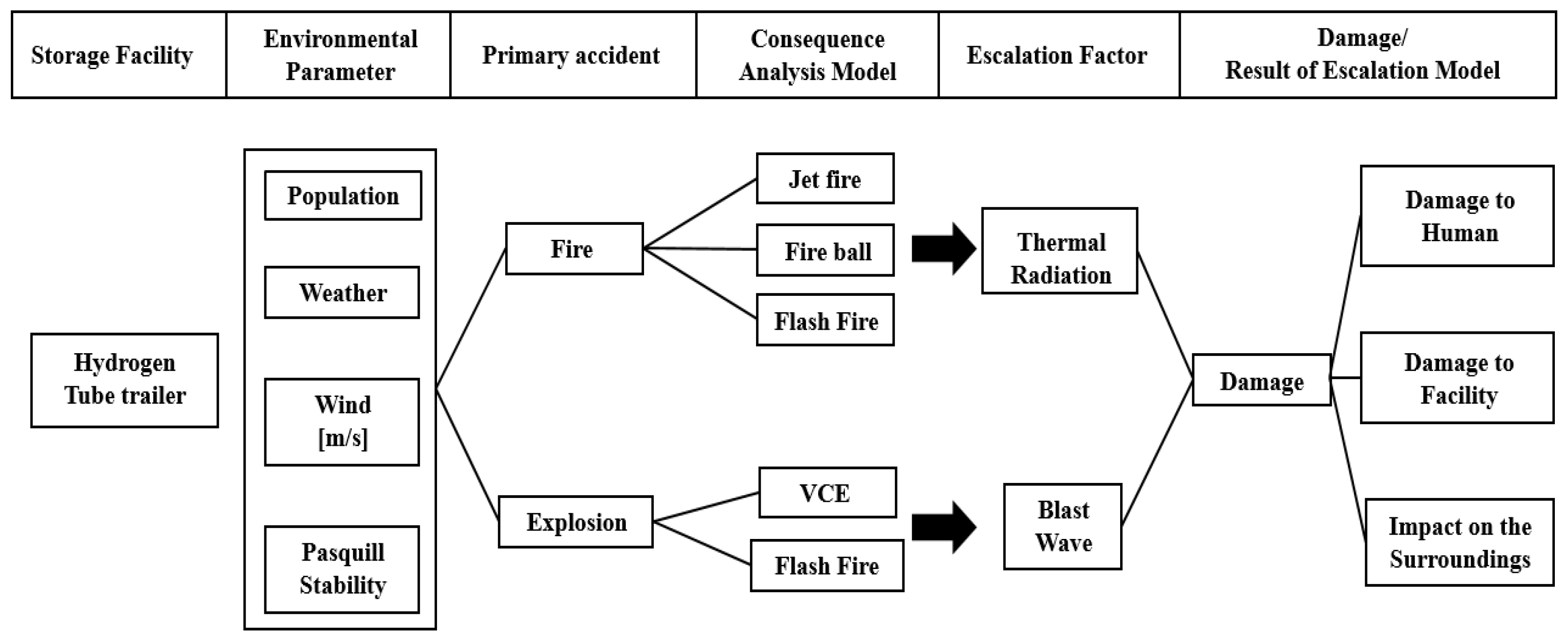

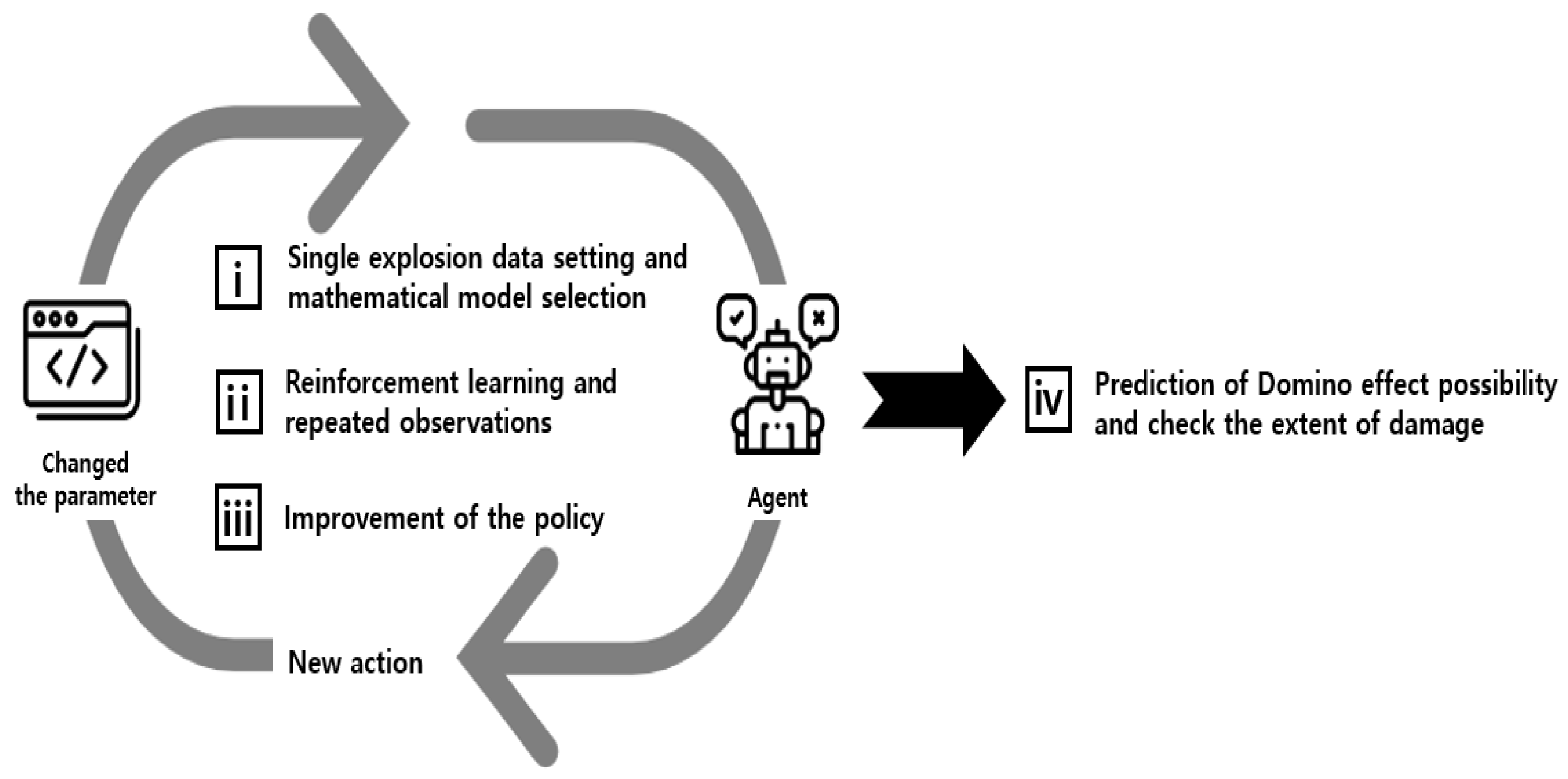
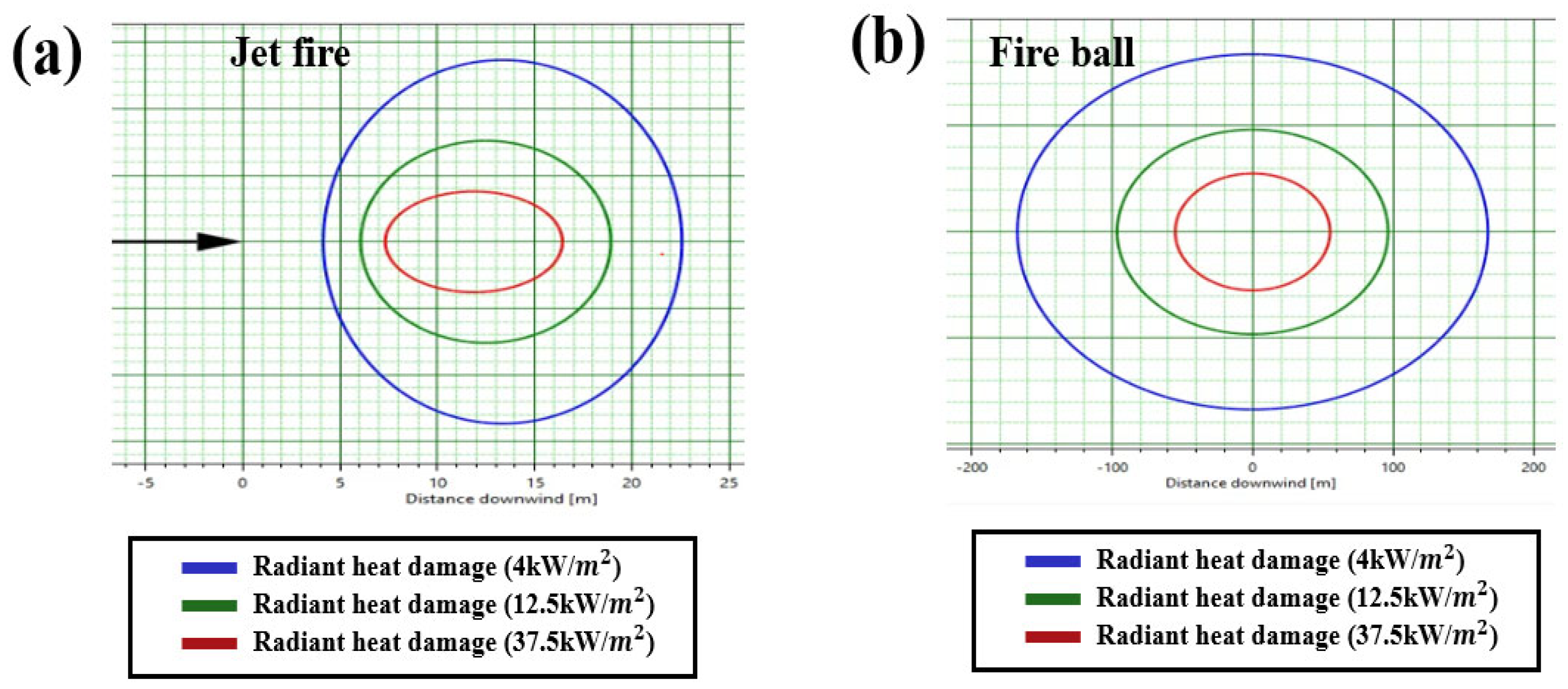
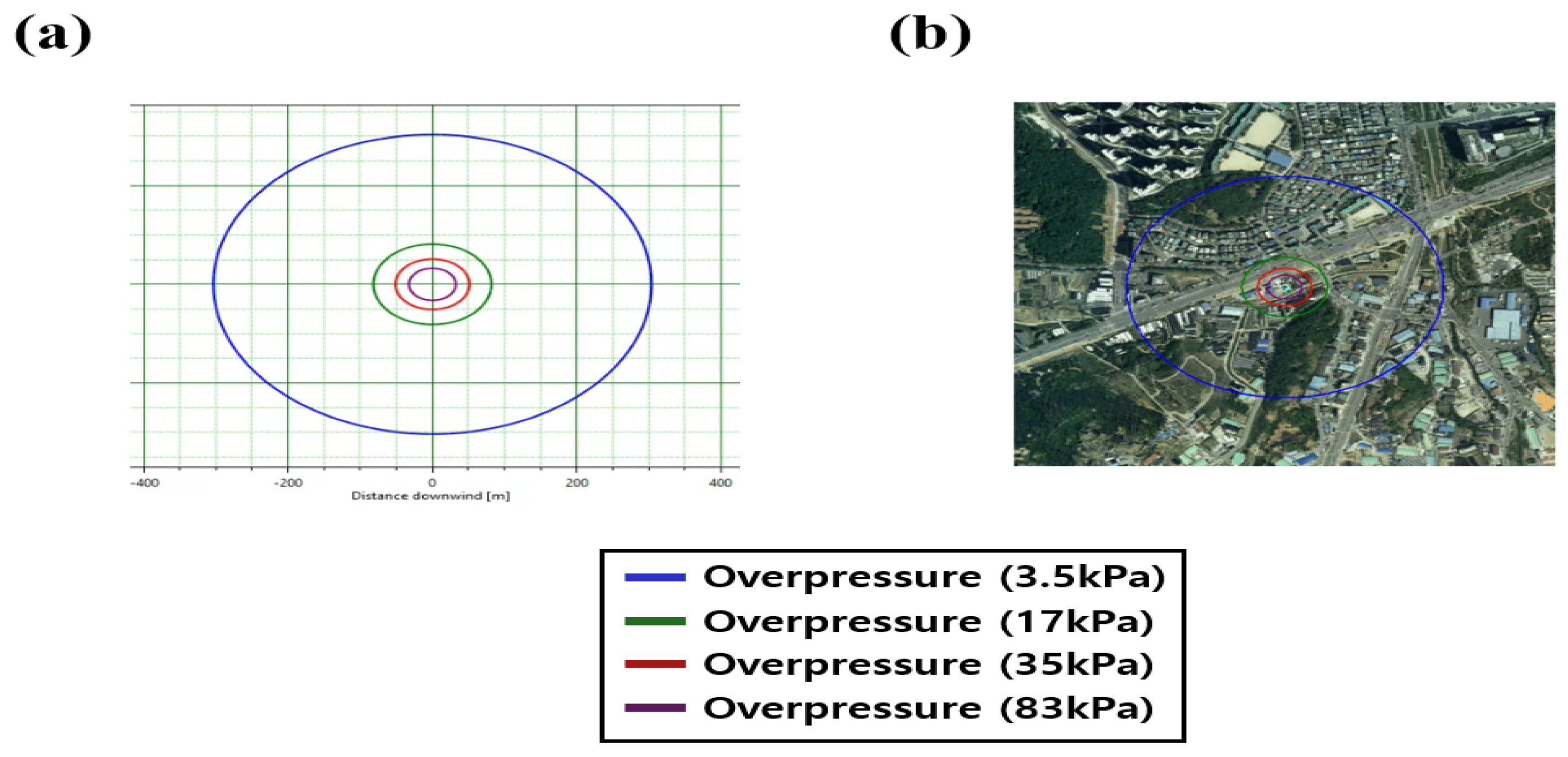
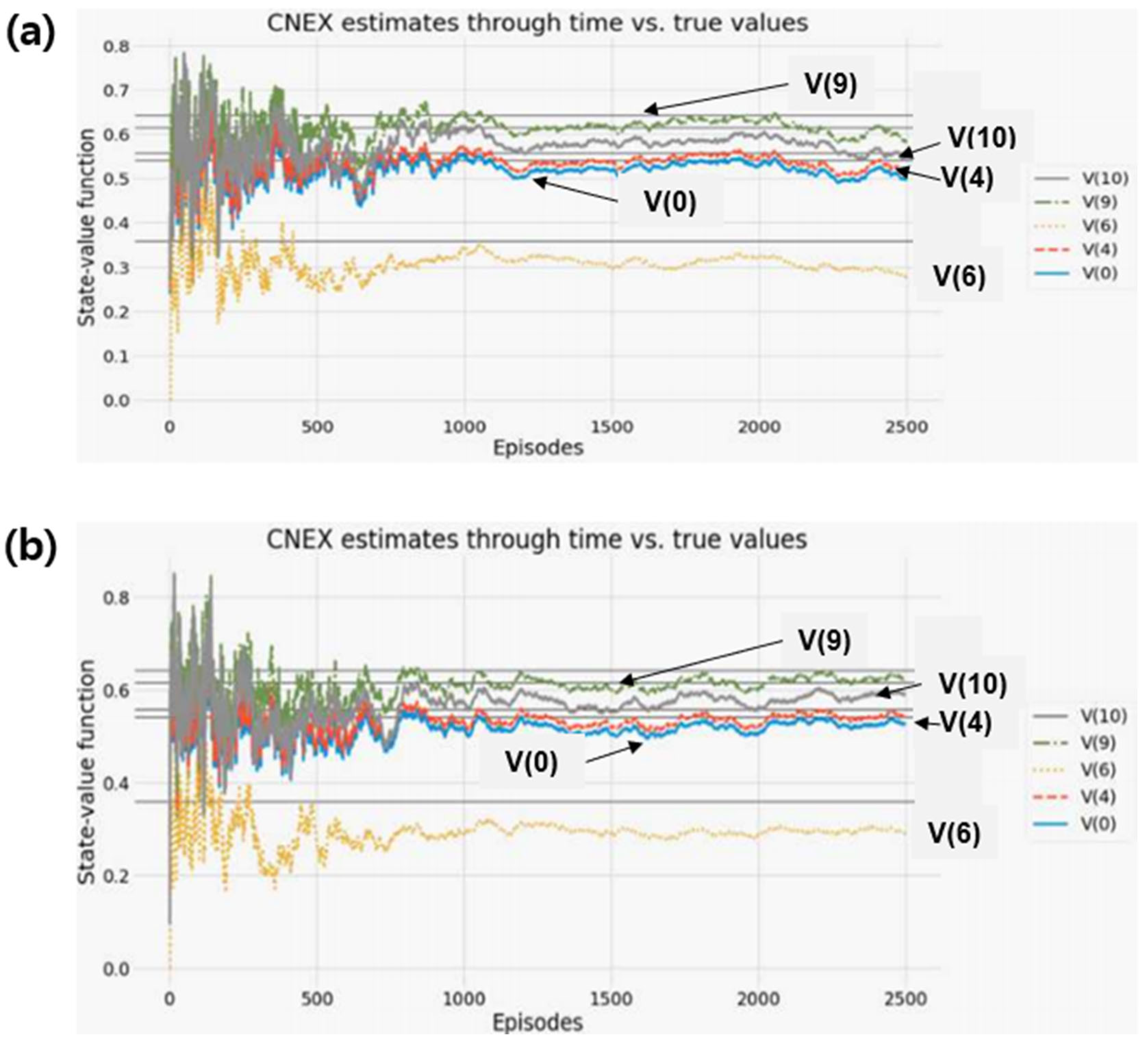

| Components | Title 2 | Leak Scenario | Leak Frequency (/Year) | ||||
|---|---|---|---|---|---|---|---|
| Pre. (MPa) | Temp. (°C) | Mass × Number | |||||
| H2 | Tube Trailer | 20 | 40 | 340 kg × 2 | Small Leak | 1.07 × 10−3 | |
| Medium Leak | 3.21 × 10−4 | ||||||
| Large Leak | 1.80 × 10−4 | ||||||
| Cat. Rupture | 5.00 × 10−7 | ||||||
| H2 High- Pressure Storage | 82 | 40 | 0.343 m3 × 2 | Small Leak | 3.47 × 10−3 | ||
| Medium Leak | 2.09 × 10−4 | ||||||
| Large Leak | 1.02 × 10−4 | ||||||
| Cat. Rupture | 5.00 × 10−7 | ||||||
| H2 Low- Pressure Storage | 40 | 40 | 0.343 m3 × 2 | Small Leak | 3.47 × 10−3 | ||
| Medium Leak | 2.09 × 10−4 | ||||||
| Large Leak | 1.02 × 10−4 | ||||||
| Cat. Rupture | 5.00 × 10−7 | ||||||
| Dispenser | 70 | -40 | - | Small Leak | 7.06 × 10−4 | ||
| Medium Leak | 1.85 × 10−4 | ||||||
| Large Leak | 9.88 × 10−5 | ||||||
| Compressor | 82 | 40 | - | Small Leak | 2.76 × 10−3 | ||
| Medium Leak | 2.62 × 10−6 | ||||||
| Large Leak | 4.24 × 10−6 | ||||||
| Priority Panel | 82 | 40 | - | Small Leak | 1.20 × 10−3 | ||
| Medium Leak | 8.32 × 10−5 | ||||||
| Large Leak | 3.84 × 10−5 | ||||||
| Pressure(kPa) | Levels of Damage to Buildings and Property under Pressure |
|---|---|
| 3.5 | Small damage (Large and small windows usually shattered: Occasional damage to window frames |
| 17 | Medium damage (Concrete or cinderblock walls, not reinforced, shattered) |
| 35 | Serious damage (Wooden utility poled snapped: tall hydraulic press In the building slightly damaged) |
| 83 | Total collapse (Probable total destruction of buildings; Heavy machine tools moved and badly damaged) |
| Weather (Seoul) | Wind [m/s] | Pasquill Stability Class | Temperature [K] |
|---|---|---|---|
| Summer day | 5 | D | 303.15 |
| Winter day | 2.5 | F | 268.15 |
| Summer night | 3 | D | 293.15 |
| Winter night | 2 | F | 283.15 |
| Population | Operator | Vehicle | People |
|---|---|---|---|
| Day | 8 | 80 | 150 |
| Night | 4 | 20 | 40 |
| Function MCS Training: # Train a RL agent by MCS algorithm Input: a random target policy Initialize: V(s) R, arbitrarily, for all s S Returns(s) ← an empty list, for all s S Repeat forever (for each episode): Generate an episode following : , , , …, , , , G ← 0 Loop for each step of episode, t = T − 1, T − 2, …, 0: G ← G + Unless appears in , , …, : Append G to Returns () V( ← average (Returns ()) |
| Components | Leak Scenario | Overpressure (kPa) | Explosion Impact (m) |
|---|---|---|---|
| Tube trailer | Catastrophic rupture | 3.5 | 304 |
| 17 | 81.7 | ||
| 35 | 51.3 | ||
| 83 | 32.5 |
Disclaimer/Publisher’s Note: The statements, opinions and data contained in all publications are solely those of the individual author(s) and contributor(s) and not of MDPI and/or the editor(s). MDPI and/or the editor(s) disclaim responsibility for any injury to people or property resulting from any ideas, methods, instructions or products referred to in the content. |
© 2024 by the authors. Licensee MDPI, Basel, Switzerland. This article is an open access article distributed under the terms and conditions of the Creative Commons Attribution (CC BY) license (https://creativecommons.org/licenses/by/4.0/).
Share and Cite
Lee, K.; Kang, C. Expansion of Next-Generation Sustainable Clean Hydrogen Energy in South Korea: Domino Explosion Risk Analysis and Preventive Measures Due to Hydrogen Leakage from Hydrogen Re-Fueling Stations Using Monte Carlo Simulation. Sustainability 2024, 16, 3583. https://doi.org/10.3390/su16093583
Lee K, Kang C. Expansion of Next-Generation Sustainable Clean Hydrogen Energy in South Korea: Domino Explosion Risk Analysis and Preventive Measures Due to Hydrogen Leakage from Hydrogen Re-Fueling Stations Using Monte Carlo Simulation. Sustainability. 2024; 16(9):3583. https://doi.org/10.3390/su16093583
Chicago/Turabian StyleLee, Kwanwoo, and Chankyu Kang. 2024. "Expansion of Next-Generation Sustainable Clean Hydrogen Energy in South Korea: Domino Explosion Risk Analysis and Preventive Measures Due to Hydrogen Leakage from Hydrogen Re-Fueling Stations Using Monte Carlo Simulation" Sustainability 16, no. 9: 3583. https://doi.org/10.3390/su16093583





